Wherein I analyze our currently hyperactive-information culture in the pursuit of hidden truths and the painfully obvious. I've enjoyed an art or two.
Tuesday, January 21, 2014
Amygdala project (2010-)
Started in 2010, I wanted to challenge the viewer with a series of images that blends the modern visualizations of sex with deep-routed fears: mental illness, incapacitation, cancer, etc. The first project utilized thermoplastic and latex to illustrate a pin-up glam model simultaneously undressing and undergoing an aggressive ductal carcinoma. As the images and poses become more suggestive, the spreading cancer ramps up it's aggression. The make-up enhancements grow to an exaggerated degree as an attempt to hide the inevitable. I plan on doing several more in the set, through 2014 and 2015. Here is the first set, finished in 2011.
Realism, Schmealism: Magritte's Destruction of the Real in one Un-smokable Piece.
 The Treachery of Images Rene Magritte. 1929. Oil on Canvas. Work currently at the Los Angeles County Museum of Art.
I had the pleasure in 2007 to visit LACMA during the incredible Magritte show, "Magritte and Contemporary Art: the Treachery of Images." Works by Johns, Celmins, Gober, Baldessari, Ruscha, Artschwager, Kosuth, and Broodthaers were mixed with classical Magritte, and really fleshed out the influence the Belgian in the bowler hat has had. I spent hours here, but much of my time was spent really enjoying his signature work. It's not a big one. The colors are rather plain, and despite Baldessari's excellent design of the exhibit, could have been easily overlooked. However, once you see it, it's surprisingly challenging over eighty years after it was first shown. Your immediate reaction, regardless any art education you have received, is to argue against the key point. Of course it's a pipe! It was a visceral, snap reaction I had despite writing a few briefs on Magritte before. You can't avoid it.
Artists often launch into wordy, meandering defenses of their work when it faces a challenge or criticism. Magritte had perhaps the best:
"Of course it's not a pipe, just try to fill it with tobacco!"
The antagonist's reaction to Magrittes defense was, I imagine, a lot of sputtering, perhaps cursing.
But in one fell swoop with this image, the concept of representation has been pushed to collapse. It is a painting. Nothing more, nothing less. A painting of an object is not the object. Since that long-held-notion of "representation" is shattered, one can relabel what one creates regardless what it "looks like". This decoupling of real object vs "represented" object has far-flung consequences, if you think about it. How much legalese and advertising today is based on this principle of direct disassociation?
The surrealists represented the first long-term movement following the disastrous Great War. The disconnection of projected truth (what is printed or shown) from reality was made clear throughout World War One, particularly for a younger generation who saw the enormous carnage at the front line yet, when injured and sent home, would see a totally whitewashed press convinced of a "victory" that simply wasn't materializing.
Our own politicians continue with this. Hell, they couldn't survive, particularly today, without a total disconnect from fact in favor of a glorious projection.
But my political views aside, Magritte's image is "meta" in every sense of the word. With one simple image and a seemingly contradictory statement, he burned down thousands of years of implied wisdom in the desire to depict the real: the artist cannot create reality. Some can come tantalizingly close, some come through in ways we don't immediately accept (the cubists), and some just say "fuck it."
The Treachery of Images Rene Magritte. 1929. Oil on Canvas. Work currently at the Los Angeles County Museum of Art.
I had the pleasure in 2007 to visit LACMA during the incredible Magritte show, "Magritte and Contemporary Art: the Treachery of Images." Works by Johns, Celmins, Gober, Baldessari, Ruscha, Artschwager, Kosuth, and Broodthaers were mixed with classical Magritte, and really fleshed out the influence the Belgian in the bowler hat has had. I spent hours here, but much of my time was spent really enjoying his signature work. It's not a big one. The colors are rather plain, and despite Baldessari's excellent design of the exhibit, could have been easily overlooked. However, once you see it, it's surprisingly challenging over eighty years after it was first shown. Your immediate reaction, regardless any art education you have received, is to argue against the key point. Of course it's a pipe! It was a visceral, snap reaction I had despite writing a few briefs on Magritte before. You can't avoid it.
Artists often launch into wordy, meandering defenses of their work when it faces a challenge or criticism. Magritte had perhaps the best:
"Of course it's not a pipe, just try to fill it with tobacco!"
The antagonist's reaction to Magrittes defense was, I imagine, a lot of sputtering, perhaps cursing.
But in one fell swoop with this image, the concept of representation has been pushed to collapse. It is a painting. Nothing more, nothing less. A painting of an object is not the object. Since that long-held-notion of "representation" is shattered, one can relabel what one creates regardless what it "looks like". This decoupling of real object vs "represented" object has far-flung consequences, if you think about it. How much legalese and advertising today is based on this principle of direct disassociation?
The surrealists represented the first long-term movement following the disastrous Great War. The disconnection of projected truth (what is printed or shown) from reality was made clear throughout World War One, particularly for a younger generation who saw the enormous carnage at the front line yet, when injured and sent home, would see a totally whitewashed press convinced of a "victory" that simply wasn't materializing.
Our own politicians continue with this. Hell, they couldn't survive, particularly today, without a total disconnect from fact in favor of a glorious projection.
But my political views aside, Magritte's image is "meta" in every sense of the word. With one simple image and a seemingly contradictory statement, he burned down thousands of years of implied wisdom in the desire to depict the real: the artist cannot create reality. Some can come tantalizingly close, some come through in ways we don't immediately accept (the cubists), and some just say "fuck it."
Old notes at AOS about Duchamp
Another old bit from Ace of Spades, comments about Duchamp ...
Funny thing is, I have had morons comment on this piece in multiple threads, and they actually sum it up well:
To all of the morons who had commented on it in the original threads, I will add just a bit more. Duchamp was being profound by pushing the ever-expanding boundaries of art to its inevitable conclusion- one in which the actual ability or skill of the artist is deemed irrelevant by the simple pronouncement of a given "work" as art. He geniunely believed that the declaration of art, and an audience, mattered as much if not more than the artist or his actual work. In the hands of tongue-in-cheek Duchamp, this idea is both thoughtful and comical- we can take the proposition seriously, but simultaneously laugh at its implications humorously expressed. As for the copycats and the beatniks whose "art" erronously shove themselves onto the Duchampian family tree, I simply give you Salvador Dali's reaction to them:
After the First World War, allegiances to many of the artistic traditions that had survived the challenges of cubism, expressionism, impressionism, fauvism and pure abstraction were shattered by a disillusioned, cynical generation of artists who inadvertently predicted much of what makes art "suck" in the eyes of today's majority. The most brilliant of these was Marcel Duchamp, whose horny woman-and-gay da Vinci two-for-one joke LHOOQ was blogged about here earlier:


Fountain, 1917. (photo from 1917 exhibition) Porcelain Urinal.
Original lost, replicas at various institutions.
Funny thing is, I have had morons comment on this piece in multiple threads, and they actually sum it up well:
Duchamp ushered in modern art by establishing the idea of "ready made" art, which fit nicely with new developments in mass manufacturing, and it was an asshole, curmudgeonly comment on the modern age, anticipating the beatniks by several decades. He was a typical French misanthrope who stated that art has nothing to do with the artist once it's on display. The viewer gets to decide whether it's art, and they can "piss off." There was always punk.Posted by: Tattoo De Plane
That's the idea. Or half the idea. Duchamp was the original "Art is whatever crap I put my name (or someone else's) on" guy. So when he did it, it was funny. It worked like a Don Rickles joke. If you're an art-world dink who thinks you're in on Duchamp's joke, and you're like "He's doing me! I'm in the show!" you can laugh and have a good time when he says you look like a drunk Mexican gorilla, but it's funny because you look like a drunk Mexican gorilla.Posted by: oblig.
Here's a thought on the Duchamp: In the novel Infinite Jest, one of the characters, a filmmaker, pulls a huge hoax on the art world. He comes up with a concept called "found drama". Basically it goes like this: You pick a name out of the phone book, and whatever that person does for the next two hours is the "drama". You don't have to know what they actually do. Just the act of designating the person is the "art". It makes a big splash in the art world, until he reveals that it's all bullshit, at which point everybody gets pissed at him. That's pretty much how I feel about "Fountain" (only Duchamp never let the cat out of the bag).Posted by: Farmer Joe
When Marcel Duchamp created "Fountain" in 1917 under the pseudonym "R. Mutt" as part of his "readymades", he was making a deliberate swipe at Western mainstream "fine art" traditions of elevating anything to art simply by setting it on a pedestal. Apparently, modern "artists" never quite got the joke. Posted by: The Ghost of Flannery O'Connor
To all of the morons who had commented on it in the original threads, I will add just a bit more. Duchamp was being profound by pushing the ever-expanding boundaries of art to its inevitable conclusion- one in which the actual ability or skill of the artist is deemed irrelevant by the simple pronouncement of a given "work" as art. He geniunely believed that the declaration of art, and an audience, mattered as much if not more than the artist or his actual work. In the hands of tongue-in-cheek Duchamp, this idea is both thoughtful and comical- we can take the proposition seriously, but simultaneously laugh at its implications humorously expressed. As for the copycats and the beatniks whose "art" erronously shove themselves onto the Duchampian family tree, I simply give you Salvador Dali's reaction to them:
The first person to compare the cheeks of a young woman with a rose was plainly a poet. The second, who repeated the comparison, was probably an idiot...People have already forgotten that the founder of Dadaism, Tristan Tzara, stated in his mannifesto in the very infancy of the movements: "Dada is this, Dada is that...Either way, it's crap." This kind of more or less black humour is foreign to the new generation. They are genuinely convinced that their neo-Dadaism is subtler than the art of Praxiteles.
Levitated Mass (from AOSHQ)
This was posted over at Ace of Spades back in June of 2012, and since it's about my favorite public artwork, I'm cross-posting it here.
After posting yesterday, I decided to overcome my usual resistance to visit an exhibit or piece on opening day, just to further spite those of you angry at a rock being called art. Full disclosure: part of my hyping this has been a reaction to the absurdity of this on paper. The sheer cost and energy put into creating this work went beyond any adjective I can summon without grinning, though as a conservative I find it refreshing how this came to be: artist Michael Heizer found a way to get his 40-year vision off paper and, with $10 million all privately raised, onto Miracle Mile.
I thought about what I would probably write, whilst making Mrs CAC her Starbucks Surprise (grain alcohol and ginger ale in a Starbucks cup for the long drive). I was probably going to focus on the positives of minimalism, on the hype, on a hundred things I didn't. Yesterday was perfect: high 70s, light breeze, and a waxing crescent moon suspended in the bright blue California sky. You couldn't ask for better weather while enjoying outdoor sculpture. Or when having an epiphany.
Passing Wilshire, the plaza came into full view, along with the crowd. Surprise, even at 5:30 there were still hundreds milling about the campus. If you decide to make the trip, it is free: just enter the park entrance on 6th street and walk towards the Big Fucking Rock. You really can't miss it. Even if the ranting street lunatics try to distract you on Fairfax. Once inside the plaza the gigantic rock is hard to miss:
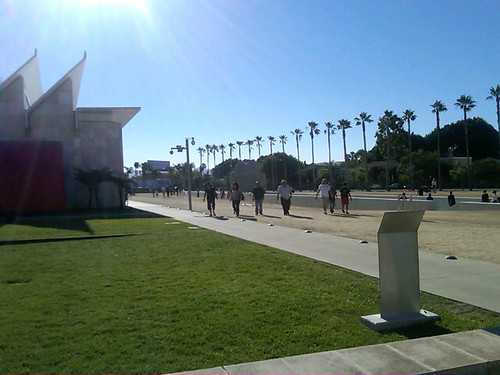

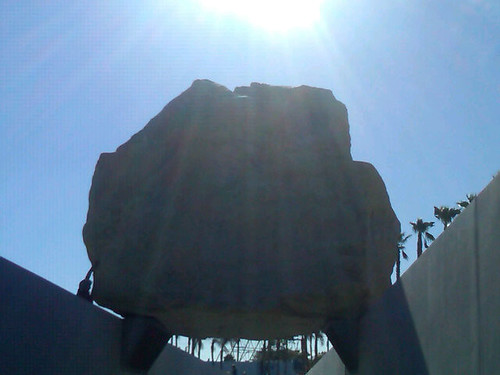
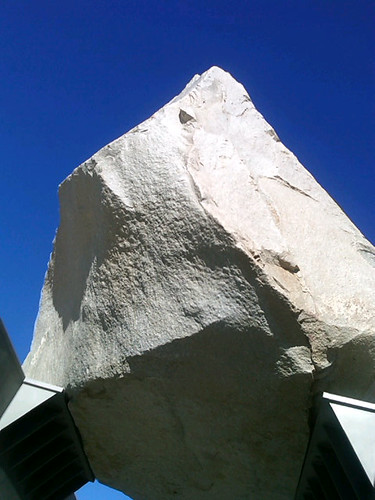

One of two measly buttresses supporting the 680,000 lb stone
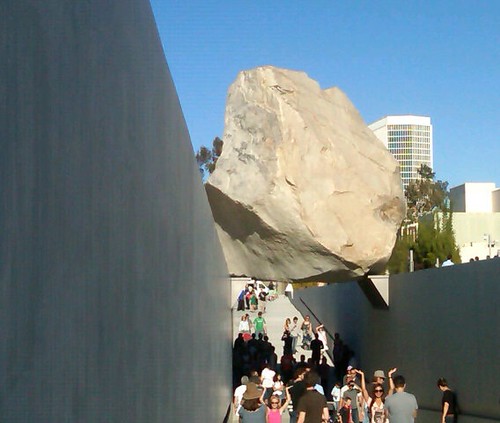
Shape of the channel also throws off perspective for size. Rock looks monstrous over the people shadowed underneath
Why?
Why was this done? What was he seeing in the desert in the 1960s when he thought this project up? Why here, in an urban landscape? Snarky answers aside, I was determined to figure it out. The boulder was moved over a hundred miles on a massive rig and dropped over a concrete channel. The rock was secured in place with bolts and buttresses but appears to be just resting there precariously. When the Big One finally hits, it will likely levitate a lot less.
As I'm staring at the rock above me, contemplating the why, I get distracted with the usual troubles in my mind. Debt. More debt with the wedding coming up. My father-in-law's fight with Alzheimers. Bigger problems start racing through my mind- the recession, the upcoming election, etc. The stress of the last few years has weighed on a lot of people. Getting annoyed I'm being mentally derailed while starting at granite, I began to move up the channel, out and away.
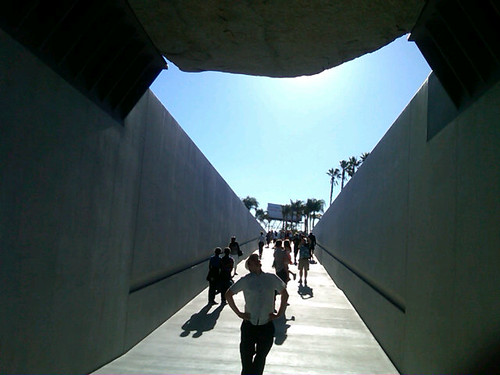
Actual moment of epiphany while wearing a stupid hat
That's it. Man has always been in awe of nature and natural forces. We seem so small compared to the bigness of everything around us. As an amateur astronomer, staring out at the Whirlpool Galaxy really brings things down to size. We can be overwhelmed by the massiveness of things we encounter and experience, but we have this sensation because unlike the rest of creation we are aware of ourselves. We have thought, and as such can make our own choices independent of what the rest of our surroundings may intend.
The work is there to challenge you. The mass, dangling over you, a reminder of the countless aspects of our lives we seem to have little control over. The implication of being squished brings to mind the greatest one: death. Not a lot of choices right there in that gigantic hulking mass of indifferent nothing. But the channel is the real key to the work being successful. We move downwards to encounter the mass, to challenge it. Unlike the gigantic boulder, we can keep moving. We make the conscious choice to engage the things we may often find overwhelming.
We also have the choice to beat them back and emerge with a greater sense of ourselves. The rock harkens back to the millenia-long use of stone to symbolize the eternal. I thought the press releases mentioning this were pure quackery, but it is dead right. The rock symbolizes everything we encounter that may intimidate us but which we choose to approach and deal with anyway. The Man V Nature narrative is often the David V Goliath of conflict stories. Storms, earthquakes, tsunamis, volcanoes, swarms etc all spell out a battle that seem to imply poor odds for us. But since we have conscious thought, man can, if he chooses, have the upper hand against most things.
In man's conquest of his surroundings and in his personal battles, we have choices, especially when we break down what is challenging us. Their massiveness is often an illusion, the threat less grave when we actually face them. The 340 ton granite and gravity would love to squash you like a bug, but (for now), it can't. It just sits there. Less awe-inducing, and more pitiful, as visitors pose for cameras, a guy dressed like Jesus staggers around it (seriously, you had to be there), and crap art critics bloviate from under it.
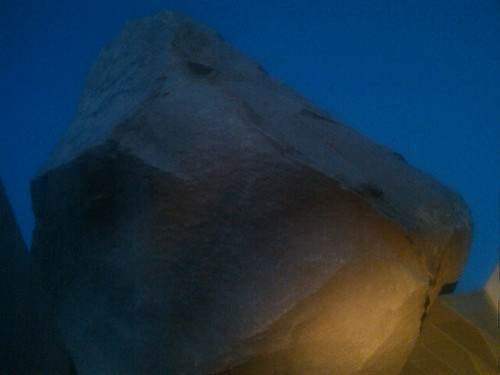
So long, Sweet Megalith Of Death
Final verdict: definitely worth the trip.
Beer helps too.








Subscribe to:
Posts (Atom)











